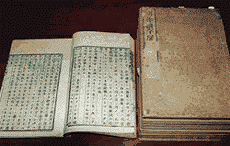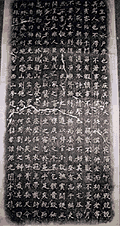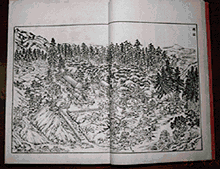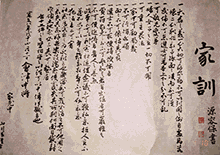6. Hagakure's criticism on "affected martial arts as Kyoto
style"
As a conceptual backbone of this tycoon regime, what has come into Japan through Ming's
surviving retainer is the thoughts of Confucianism. The Middle Age in Japan was what we
call the age of Buddhism, while Confucianism was nothing but an educational part for
priests. But, from then on, Confucianism came to Japan at a stretch, as a legal system. As
a result, the "affected martial arts as Kyoto style" and Japanese chivalry, with
the backbone of Confucianism which was criticized by Hagakure itself, were born. This
conceptual environment is also a kind of rigorous "nomocracy." Nitobe Inazo's
"Bushido" is a good instance in this meaning.
This Japanese chivalry is stylistic, as well as rational and intellectual, contrary to
sympathy and substantiality of another type of chivalry. The root of nomocracy or
bureaucracy in Japan, with a negative sense, lies here.
Ruth Benedict, an American anthropologist, called the Japanese culture as a "culture
based on the sentiments of shame." It can be substituted for nomocracy with a
negative image. For example, the former (pre-war) Japanese laws had no word equivalent to
"defeat." Such a word or term was unthinkable and could not be allowed at all.
On the other hand, when loosing the World War II and the authorities ordered to obey the
U.S., as symbolized by the GHQ, the Japanese people obeyed dutifully them, to which, as a
matter of fact, Japan had been anathematizing only yesterday. Benedict was very surprised
at such drastic transformation of the Japanese people. |
|
 |
Ogyu Sorai's
"Minritsu Kokuji Kai"
A commentary book on the Chinese criminal law, written at the middle of the Edo Period |
|
|
| One of those who propelled such Japanese chivalry was Mito Komon. He, at 18 years old,
read "Shi ji(historiography)" written by Si ma Quian, a Chinese hisotiran,
impressed by the episodes of Hakui and Shukusei, and put his political basis on the
concept of the historiography. |
|
 |
Mito Komon's
monument of honorable Bairi
A grave with the epitaph in which Mito Komon's concepts on nation and family. He built the
grave while he was alive. |
|
|
 |
Mito Komon's
painting of Seizan So
Seizan is a mountain in China. The painting is characteristic of Chinese landscape. |
|
|
 |
Portrait of
Yoshida Shoin
Yoshida Shoin, a royalist during the Meiji Restoration, was also strongly influenced by
the Mito School. |
|
|
| On the other hand, Hoshina Masayuki, Komon's friend and relative at Aizu, cherished
this same concept. |
|
 |
Insert here the
family precepts of the Aizu clan.
The family precepts of the seignior of the Aizu (Fukushima Prefecture, now) clan. |
|
|
 |
Insert here the
precepts for children of the Nisshin Kan of Aizu.
The basic doctrine of the Aizu clan's chivalry |
|
|
 |
Seigun Grave Yard
The defeated Aizu people enshrined the fallen who attacked, at the Meiji Restoration. |
|
|
| At any rate, on the premises of these arguments, a lord can, without condition, limit
the citizens' liberty and properties. But, there exists a Chinese point view of nation
that an anarch must protect its citizens. This is, however, a Confucian chivalry. We have
to say that there is a misunderstanding that Japanese chivalry is this. |
|
[ HOME | BACK(4-5) | NEXT ] |
![]()